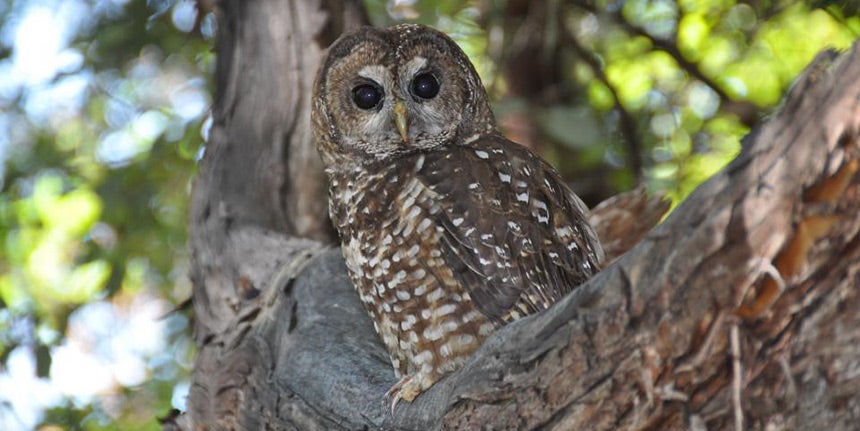By Trina Wood, UC Davis, January 23, 2018
 |
| Northern spotted owls, a threatened species, are being harmed by rat poisoning suspected to be coming from illegal marijuana farms in California. (J. Mark Higley/Hoopa Tribal Forestry) |
Rodents often get a bad rap — and for good reason. They leave droppings in our homes and attics that may spread disease. They chew through the electrical wire. They nibble irrigation lines. They raid tomato gardens and fruit trees.
That’s why people use rodenticide to poison them. The problem is that anticoagulant rodenticides have a ripple effect in the environment. Not only do they kill mice and rats, they can also result in death or serious disease of wild rodents and other wildlife that feed on the rodents or come into direct contact with the poison.
A collaborative research team, including UC Davis epidemiologist Janet Foley, recently found that bobcat populations in urban Southern California are subject to the combined effects of urbanization and exposure to these poisons. Bobcats with anticoagulant rodenticides in their system were more likely to suffer from notoedric mange — or feline scabies — a disease that causes animals to lose hair and protein through their skin, makes them anemic and leads to a slow, painful death.
Rat poison directly linked to organ function in wildlife
“This is the first time that these anticoagulant rodenticides have been directly linked to changed immune system and organ function in wildlife,” Foley explains. “From this study, we need to look at other species exposed to [the poison] and ask if their immune system has changed and what can we do about that.”
The study, led by UCLA graduate student Laurel Serieys, appeared in Proceedings of the Royal Society and included researchers from UCLA, UC Santa Cruz, University of Cape Town, Duke University, University of Tasmania, the National Park Service and Colorado State University.
The dangers of anticoagulants to wildlife have been known since 2012 when Mourad Gabriel, a research faculty member with the UC Davis Karen C. Drayer Wildlife Health Center within the School of Veterinary Medicine’s One Health Institute, led a study that identified anticoagulant rodenticides as the cause of death in fishers — weasel-like mammals living in rugged areas of the Sierra Nevada.
Rodenticide suspected coming from illegal marijuana farms

Anticoagulants inhibit the ability of an animal to recycle vitamin K, which creates a series of clotting and coagulation problems that can lead to uncontrollable internal bleeding and death. Gabriel, who is also executive director of the nonprofit Integral Ecology Research Center, speculated that the most likely source of the poisons was the illegal marijuana farms found throughout the Sierra Nevada.
In that initial study, of 58 fisher carcasses brought to the UC Davis California Animal Health and Food Safety Laboratory System for necropsy, 79 percent had been exposed to anticoagulant rodenticides.
Brodifacoum, a second-generation rodenticide, was found in 96 percent of the exposed fishers. Second-generation rodenticides are more toxic because they can be lethal after a single ingestion. It can take up to seven days before clinical signs appear, so the poisoned animal can be a significant risk to predators for several days before it dies.
Studies may be ‘tip of the iceberg’ regarding poison’s impact
“Unfortunately, these early investigations of rodenticide exposure in fishers that are associated with illegal marijuana cultivation on public lands might only be the tip of the iceberg with regard to the overall impact of pesticides on wildlife at these sites,” said lab system toxicologist Robert Poppenga at the time. He helped provide the rodenticide analysis in support of the investigation while his colleague, pathologist Leslie Woods, conducted the necropsies.
“I was really shocked by the number of fishers that had been exposed to significant levels of multiple second-generation anticoagulant rodenticides,” she said.
Since then, additional studies published in 2013, 2015 and 2018 point to a serious problem of deadly environmental contamination associated with marijuana sites in California
The mid-January publication by Gabriel and team was the first published account of anticoagulant rodenticide in northern spotted owls, which are listed as a threatened species under the federal Endangered Species Act and the state of California’s counterpart.
With the legalization of marijuana in California after the passage of Proposition 64 in 2016, researchers are concerned that the number and size of unpermitted cultivation sites with no management oversight will grow, which could expose wildlife to more rodenticide poisoning.
“When you have thousands of unpermitted grows and only a handful of biologists that regulate that for multiple counties, we’re deeply concerned that there aren’t sufficient conservation protective measures in place,” Gabriel said in the press release.
Marijuana cultivators creating sites for wildlife exposure
“If no one is investigating the level at which private marijuana cultivators are placing chemicals out there, the fragmented forest landscapes created by these sites can serve as source points of exposure for owls and other wildlife.”
Knowledge gained from this overall group of studies has helped scientists gain key information that could benefit the wildlife populations affected by rodenticide exposure, Foley says.
“We’ve learned some critical aspects about how anticoagulants work inside the body and how we can improve rehabilitation and survival rates for those affected animals who can still be saved,” she says.
“We’ve also gathered more information in general about anticoagulants. This data-driven information gives all California stakeholders more ability in making rational decisions about where and how to use them.”
No comments:
Post a Comment